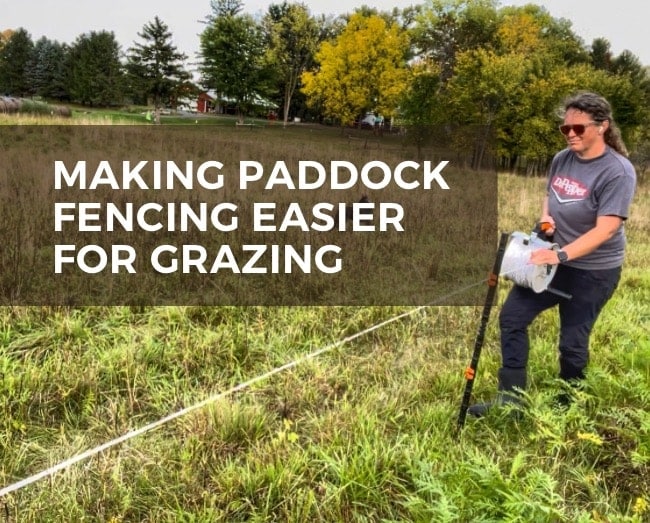I may earn affiliate income from links in the blog post. I only promote products I actually use in my farm and business.
As fall is creeping in, I’m working to finish up the last of my projects. One that’s been on the list for quite some time is updating our paddock fencing inside our permanent pasture with new posts and poly wire that’s more effective and durable.
Before I get into the project itself, let me share a little more about the strategy with this “interior fence.”
Making rotational grazing less work
We practice intensive rotational grazing on our farm, which means we’re breaking up our pastures into paddocks, smaller sections, for our goats and sheep to graze. We move them to a new paddock every 1-3 days using portable fencing.
I’m always looking for ways to be more efficient with my time, while not sacrificing the purpose and benefits of rotational grazing. After a few years of using net fence in our permanent pasture, we moved to using Smart Fence, an all-in-one reel and step in post fence system. It was much easier to set up and take down than net fence (though we still find net fence useful in other areas on our farm).
Since our three main pastures are rectangles and horseshoe around our farmyard, we run our herd through each pasture in a loop. To make it even easier to set up our paddocks, several years ago I decided to try out putting up a semi-permanent divider fence down the center of our pastures with openings with no gates. It also didn’t connect to our permanent woven wire fence. It basically was two strands of poly wire with step in posts.
For each paddock, I would just set up one Smart Fence in a straight line in the “front” and “back” of the paddock, with the other sides being already set up with my permanent woven wire fence and this semi-permanent fence. I’d then connect everything together with a jumper cable to the permanent fence hot wire.
It seems so simple, but it made setting up a paddock fence even easier because running a straight line of portable fencing requires less work of creating corners or setting anchors.
Once a year I’ll take the mower or weed wacker and trim the grass under the bottom wire and that usually does the job for minimizing any issues with grounding on the live wires.
Now several years later, I’m ready to make my setup more permanent. I’ve found that my step in posts have taken some wear with our seasonal swings in our Wisconsin weather and with UV rays. Deer have also taken out the wire a time or two and I’ve made some repairs. However, I don’t need a full set up like our permanent, perimeter fence.
The paddock fencing project update
Here’s what I’m doing for my updates to this pasture divider set up:
Replacing step in posts with insulated posts
I am taking out the old step in posts and replacing them with insulated line posts (affiliate) from Gallagher. These posts are pretty strong for plastic posts, but lighter than t-posts. I’m then using the insulated line post clips (affiliate) that can be adjusted to different heights.
We set the posts up every 30 feet based on our particular needs. Since we’re using poly wire, rather than high tensile wire, we’re not putting in H braces. But, if we decided to add high tensile, we can easily add it to these insulated line posts and add H braces at both ends of the fence line.
Replacing the standard poly wire with turbo wire
I’m replacing the standard farm store poly wire with Gallagher’s turbo wire (affiliate), which is 46x more conductive. That means it’s stronger and more effective, paired with my energizer, in helping me keep my goats and sheep fenced in.
To accommodate this set up for our winters, I’m installing the turbo wire with a reel, so I can roll up the wire at the end of the grazing season. I’ll keep the posts up, but take the wire down so it doesn’t get pulled down by the weight of the snow or deer moving through our pastures.
Supply list for project:
- Insulated fence post lines (affiliate)
- Insulated post clips (affiliate)
- Turbo wire (affiliate)
- Fence post pounder hand powered, post pounder sleeve adapter (affiliate) for harder ground, if needed
The supplies are from Gallagher, one of our favorite fencing supply providers. We’ve been using their products for over 10 years. If you’re interested in trying out any of these products, use our code CYLON for 10% off your entire order (U.S. and Canada).
Video overview of project setup and in use
Watch the video below to learn more about the fencing project set up and then how I’m using in our grazing system.

LEAVE A COMMENT
Comments